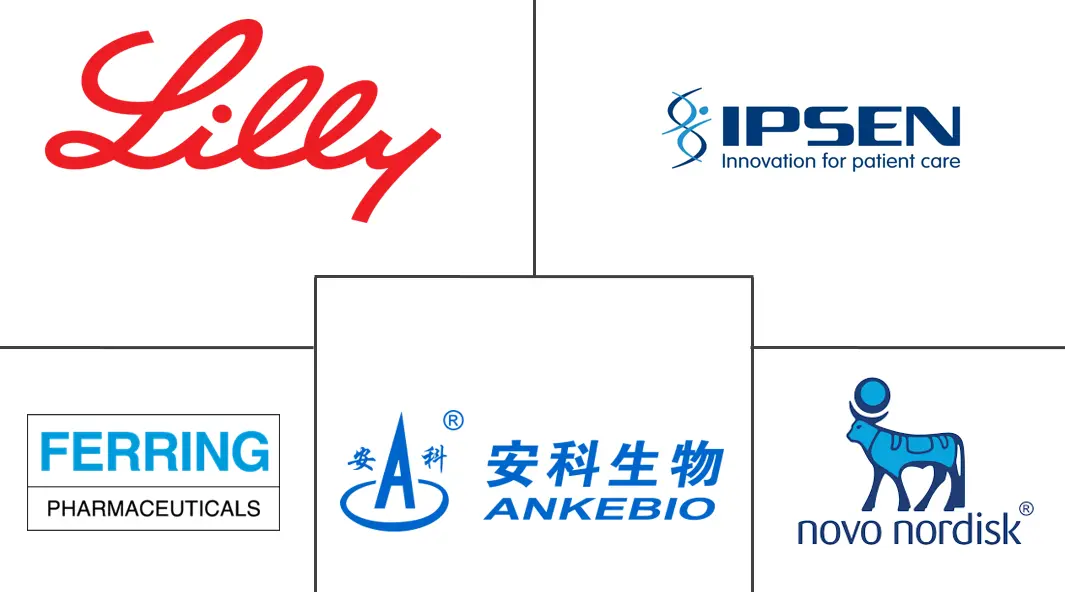Global Human Growth Hormone (HGH) Market Size and Share
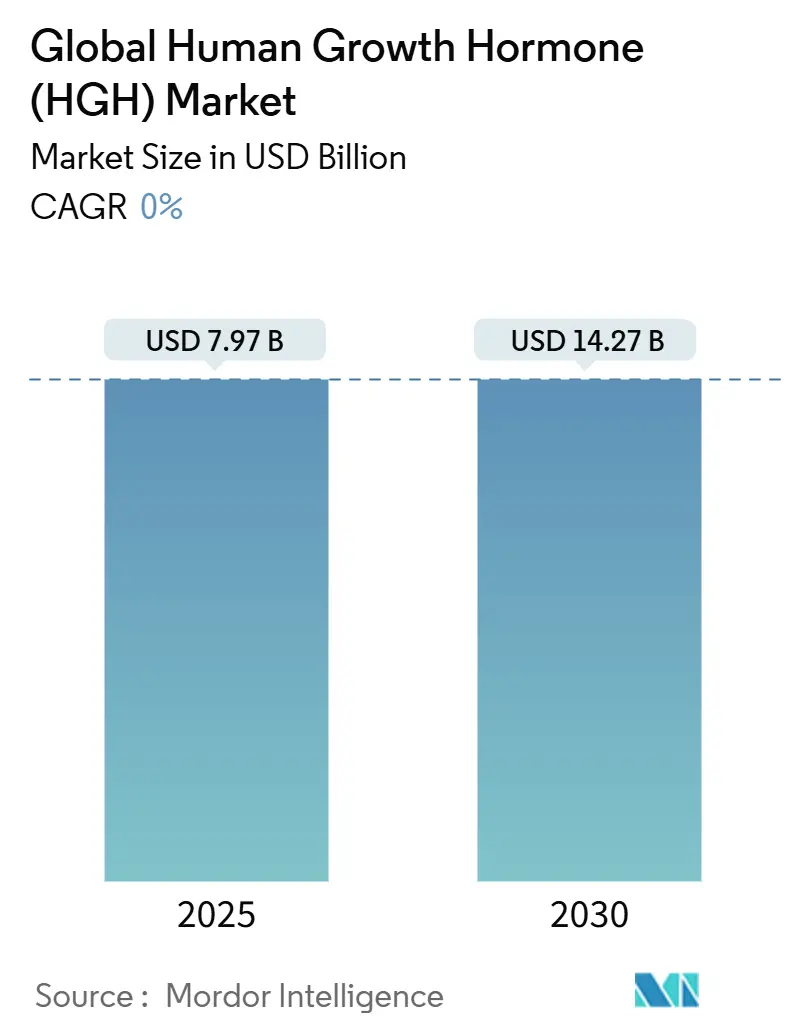
Global Human Growth Hormone (HGH) Market Analysis by Mordor Intelligence
The human growth hormone market size reached USD 7.97 billion in 2025 and is forecast to touch USD 14.27 billion in 2030, advancing at a 12.30% CAGR. Sustained progress in long-acting formulations, widening clinical indications that now span pediatric and adult populations, and multi-billion-dollar manufacturing expansions undertaken by several originator companies are the primary forces behind this growth. The competitive focus has shifted toward weekly products that reduce injection burden, while biosimilar launches simultaneously introduce aggressive price competition. Supply shortages that began in 2022 have prompted accelerated capacity projects, positioning well-capitalized firms to gain volume advantage once new lines come onstream. At the same time, digital health solutions that support adherence monitoring are being deployed to reinforce real-world outcomes and protect premium pricing within the human growth hormone market.
Key Report Takeaways
- By application, growth hormone deficiency held 43.53% of the human growth hormone market share in 2024, while idiopathic short stature is set to expand at a 12.87% CAGR through 2030.
- By route of administration, subcutaneous products commanded 65.45% share of the human growth hormone market size in 2024; oral / buccal candidates are projected to advance at 13.24% CAGR to 2030.
- By formulation, daily somatropin retained 72.35% share in 2024, whereas long-acting products are growing at a 13.65% CAGR over the same period.
- By distribution channel, hospital pharmacies controlled 48.35% revenue in 2024, yet online pharmacies record the highest forecast CAGR at 13.81% to 2030.
- By patient type, pediatric cases represented 62.35% of total prescriptions in 2024, and the adult segment is rising at a 13.67% CAGR toward 2030.
North America accounted for 42.15% of total revenue in 2024; Asia-Pacific is the fastest-growing region at 14.23% CAGR to 2030.
Global Human Growth Hormone (HGH) Market Trends and Insights
Drivers Impact Analysis
| Driver | (~) % Impact on CAGR Forecast | Geographic Relevance | Impact Timeline |
|---|---|---|---|
| Development and uptake of long-acting rhGH formulations | +2.8% | Global, early adoption in North America and EU | Medium term (2-4 years) |
| Rising prevalence of growth hormone deficiency and related disorders | +2.1% | Global, higher impact in emerging markets | Long term (≥ 4 years) |
| Expanding adult and anti-aging off-label demand | +1.9% | North America and EU | Short term (≤ 2 years) |
| Continued advances in recombinant DNA and protein-engineering platforms | +1.4% | Global, concentrated in major pharma hubs | Long term (≥ 4 years) |
| Gradual inclusion of rhGH in reimbursement formularies | +1.2% | APAC core, spill-over to MEA | Medium term (2-4 years) |
| Rare-disease fast-track incentives | +0.8% | North America and EU | Medium term (2-4 years) |
| Source: Mordor Intelligence | |||
Development and Uptake of Long-Acting rhGH Formulations
Weekly products such as Skytrofa, Ngenla, and Sogroya obtained both FDA and EMA authorizations between 2020 and 2023 and are redefining adherence expectations. Clinicians view the improved convenience as a critical determinant of long-term height velocity, which is particularly meaningful in pediatric care. Health systems also register downstream cost savings tied to better adherence, though payers flag the 15-25% price premium and subject prescriptions to prior authorization. Despite cost tensions, ongoing safety surveillance has yet to identify signals that offset the compliance benefit, underpinning durable adoption prospects inside the human growth hormone market.
Rising Prevalence of Growth Hormone Deficiency and Related Disorders
Standardized IGF-1 testing, broader stimulation-test availability, and heightened physician education are lifting diagnostic rates across pediatric and adult cohorts. Adult growth hormone deficiency—once under-recognized—is now frequently screened due to its links with metabolic syndrome and cardiovascular risk. Advanced genetic sequencing helps clinicians detect Turner syndrome, Prader-Willi syndrome, and small-for-gestational-age cases earlier, which translates into longer therapy duration per patient. Research that connects adequate growth hormone levels with bone health and cognitive performance further widens the clinical rationale for continued therapy into adulthood [1]Frontiers in Endocrinology, “Emerging Roles of GH in Adult Metabolism,” frontiersin.org.
Expanding Adult and Anti-Aging Off-Label Demand
Industry estimates place adult prescriptions for non-approved indications at almost one-third of United States volume, creating a USD 1.5-2 billion shadow segment. Specialized clinics market perceived body-composition and anti-aging benefits, fuelling demand despite FDA warnings. Regulators have intensified import alerts against unapproved injectables, yet consumer interest remains strong and spills over into legitimate adult GHD evaluation. Endocrinologists report higher referral numbers, and validated deficiency cases now start treatment earlier, supporting volume growth in the regulated channel [2]US Food and Drug Administration, “Drug Shortage: Norditropin,” fda.gov.
Continued Advances in Recombinant DNA and Protein-Engineering Platforms
Platform technologies, notably TransCon, are extending half-life without altering the native somatropin molecule, thereby preserving biological fidelity while enabling weekly or longer dosing. Novo Nordisk signed a USD 285 million agreement to exploit TransCon for additional metabolic indications, reflecting industry confidence in the approach. Upstream, optimized cell lines and purification improvements drive higher yield and lower per-gram cost, allowing both originators and biosimilar players to navigate price pressure within the human growth hormone market.
Restraints Impact Analysis
| Restraint | (~) % Impact on CAGR Forecast | Geographic Relevance | Impact Timeline |
|---|---|---|---|
| High therapy cost | -2.3% | Emerging markets, selective impact in developed markets | Medium term (2-4 years) |
| Adverse effects and safety concerns of chronic rhGH therapy | -1.8% | Global, heightened scrutiny in EU | Long term (≥ 4 years) |
| Regulatory uncertainty | -1.4% | North America and EU | Short term (≤ 2 years) |
| Counterfeit and grey-market rhGH | -1.1% | Global, focus on unregulated online channels | Medium term (2-4 years) |
| Source: Mordor Intelligence | |||
Adverse Effects and Safety Concerns of Chronic rhGH Therapy
Post-marketing data draw attention to glucose intolerance, edema, and unresolved debates over potential cancer risk in adults on prolonged therapy. The PATRO biosimilar registry continues to publish safety updates that guide physician decision-making [3]Center for Biosimilars, “PATRO Registry Safety Data,” centerforbiosimilars.com . EMA and FDA have attached rigorous long-term surveillance requirements to long-acting approvals, prompting prescribers to adopt more detailed baseline risk assessments and ongoing metabolic monitoring. While safety signals have remained manageable, the extra administrative load may deter uptake in borderline cases and moderates the overall growth trajectory of the human growth hormone market.
High Therapy Cost
Annual drug expenditure typically ranges from USD 20,000 to USD 60,000 per patient, with full cost of care sometimes surpassing USD 80,000 when monitoring and specialist visits are included. Payers now enforce step-therapy protocols that prioritize lower-cost daily biosimilars over premium long-acting products. Although biosimilars such as Omnitrope deliver 10-15% list-price savings, they have not compressed prices enough to open widespread access in lower-income countries. Out-of-pocket exposure therefore remains a formidable barrier in emerging markets despite patient-assistance programs.
Segment Analysis
By Application: GHD Dominance Faces ISS Challenge
Growth hormone deficiency generated the largest revenue pool and held 43.53% of total 2024 sales, confirming its entrenched clinical standing. The breadth of clinical data, standardized dosing algorithms, and long-standing reimbursement support sustain its leadership. Nonetheless, idiopathic short stature is recording a 12.87% CAGR through 2030 and is compressing the gap. Endocrinologists are expanding the qualifying height-standard-deviation window, and payers are gradually conceding coverage following favorable long-term efficacy publications. Turner syndrome and Prader-Willi syndrome supply stable but lower-volume demand, supported by orphan-drug policies that guarantee continued access. Chronic renal insufficiency as a use case is receding in relative importance as transplantation outcomes improve.
Continued indication diversification promotes portfolio strategies that tailor dosing devices, titration software, and support programs to each distinct cohort. Companies that align product presentation with condition-specific pathways stand to reinforce their positions within the human growth hormone market. Growth hormone deficiency accounted for 43.53% of the human growth hormone market size in 2024, underlining its weight in corporate planning.
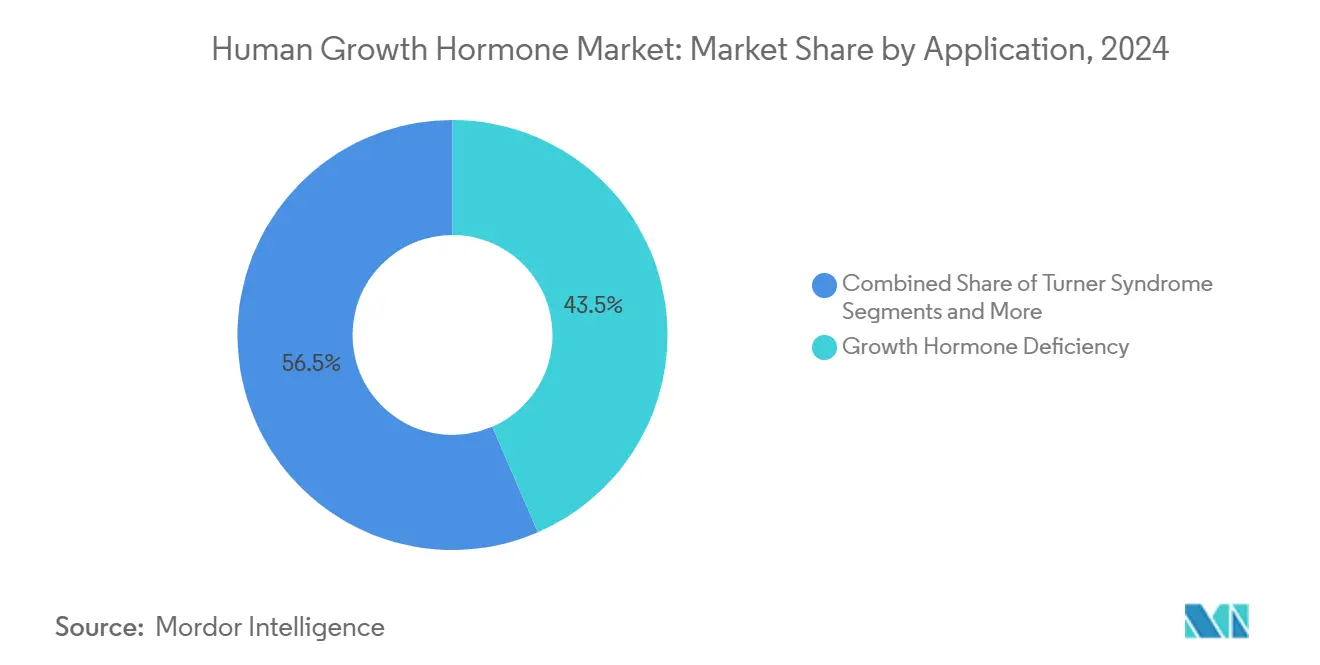
Note: Segment shares of all individual segments available upon report purchase
By Route of Administration: Subcutaneous Supremacy Under Oral Threat
Subcutaneous delivery maintained 65.45% share during 2024, enjoying decades of physician familiarity, reliable bioavailability, and integrated nurse-training infrastructure. Its scale attracts biosimilar competition, which increases price transparency but still preserves moderate margin because clinical inertia keeps daily injectables entrenched. Intravenous or intramuscular administration is confined to inpatient settings.
Oral / buccal candidates, led by LUM-201, promise a 13.24% CAGR that could meaningfully disrupt the current hierarchy once phase 3 data mature. If efficacy endpoints match injectable standards, payers may support rapid substitution due to superior adherence potential. For now, subcutaneous devices are evolving toward thinner needles and digital diary integration, which may slow near-term oral encroachment.
By Formulation: Long-Acting Revolution Accelerates
Daily somatropin still claims 72.35% revenue because of incumbent status, robust evidence, and biosimilar affordability. The reference category benefits from entrenched procurement pathways in public systems that bundle dosing devices and education services. However, weekly and monthly products are compounding at 13.65% CAGR through 2030. Initial uptake concentrates in North America and Europe where payers are more willing to balance higher acquisition cost against documented adherence gains. Long-acting launches also enjoy marketing momentum tied to improved quality-of-life scores, an increasingly decisive metric in health-technology assessments.
Future pipeline candidates seek to extend dosing intervals even further, aiming for once-monthly administration that could lock in patient loyalty and raise switching costs. Long-acting products are therefore positioned to secure a larger slice of future human growth hormone market size.
By Distribution Channel: Hospital Pharmacies Lead Digital Disruption
Hospital pharmacies distribute 48.35% of global units thanks to tight coupling between specialist visits and on-site dispensing. Their embedded prior-authorization workflows simplify payer evidence submissions and guarantee cold-chain integrity. Retail chains supplement supply for stable pediatric patients but face higher reimbursement paperwork and lower margins. Specialty pharmacies fill a bridging role where nurse-led adherence coaching is valued.
Online pharmacies occupy a small base yet are scaling at 13.81% CAGR on consumer appetite for home delivery, video consultations, and integrated refill reminders. Regulators are expanding licensing requirements and auditing that segment because counterfeit risk is disproportionately high online. Established manufacturers now partner with licensed digital platforms to safeguard product authenticity and shape the narrative in this evolving piece of the human growth hormone market.
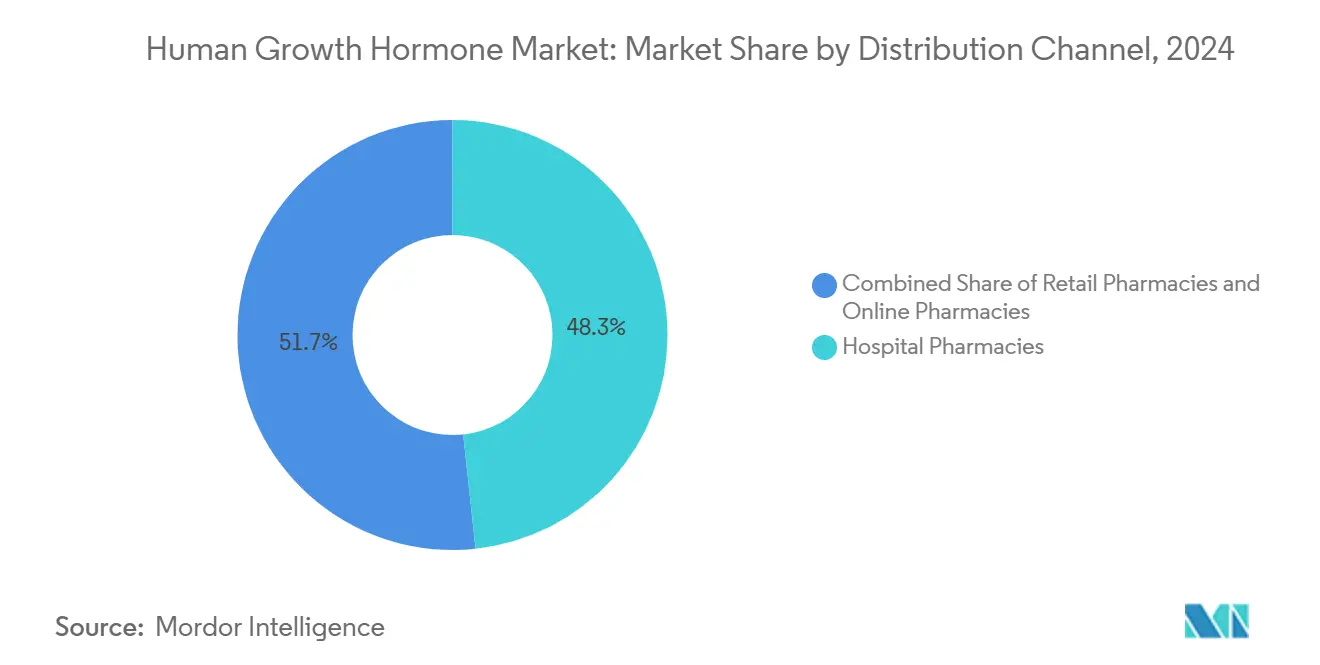
Note: Segment shares of all individual segments available upon report purchase
By Patient Type: Adult Segment Challenges Pediatric Dominance
Pediatric cases represented 62.35% of 2024 volumes and remain the reference population in most treatment guidelines. Early diagnosis under school growth-monitoring programs and insurer support for childhood height outcomes anchor pediatric demand. However, adult applications are advancing at a 13.67% CAGR through 2030 as metabolic sequelae of untreated adult GHD gain scientific clarity. Cardiovascular, bone-density, and mental-health benefits are driving refreshed guidelines that advocate replacement in documented deficiency. Reimbursement hurdles are stricter, requiring confirmatory stimulation tests and periodic efficacy review, but rising patient awareness sustains momentum.
Adult uptake diversifies revenue streams and offsets demographic headwinds in birth-rate cooling markets. Adult applications accounted for 37.65% of the human growth hormone market size in 2024 and are projected to narrow the gap over the next five years.
Geography Analysis
North America controlled 42.15% of global turnover in 2024. United States payers granted relatively broad coverage after evidence linked improved adherence with long-run cost containment, which accelerated early adoption of Skytrofa, Ngenla, and Sogroya. Canada followed with health-technology assessments that accepted weekly dosing on quality-of-life grounds within the public system. Mexico is beginning to expand insurance formularies, though cost sensitivity caps near-term penetration of premium products.
Europe contributes a sizable portion of the human growth hormone market through harmonized EMA approvals and well-structured orphan-drug incentives. Germany leads uptake of long-acting molecules and maintains robust post-marketing registries that influence safety perceptions across the continent. France and the United Kingdom enforce strict cost-effectiveness thresholds, which intensify biosimilar competition and moderate net price. Eastern European countries gradually add rhGH to reimbursement lists, leveraging pooled procurement to gain price concessions.
Asia-Pacific is growing fastest at 14.23% CAGR. China registers strong demand following insurance-catalog additions and domestic manufacturing that compresses price. Japan’s mature specialist network supports stable high-value consumption, and longitudinal patient registries contribute pivotal safety data. India, despite infrastructure gaps, shows meaningful growth as private insurance penetration rises and diagnostics improve. Local capacity investments by multinational firms aim to shorten supply lead-times and insulate the human growth hormone market against global shortages.
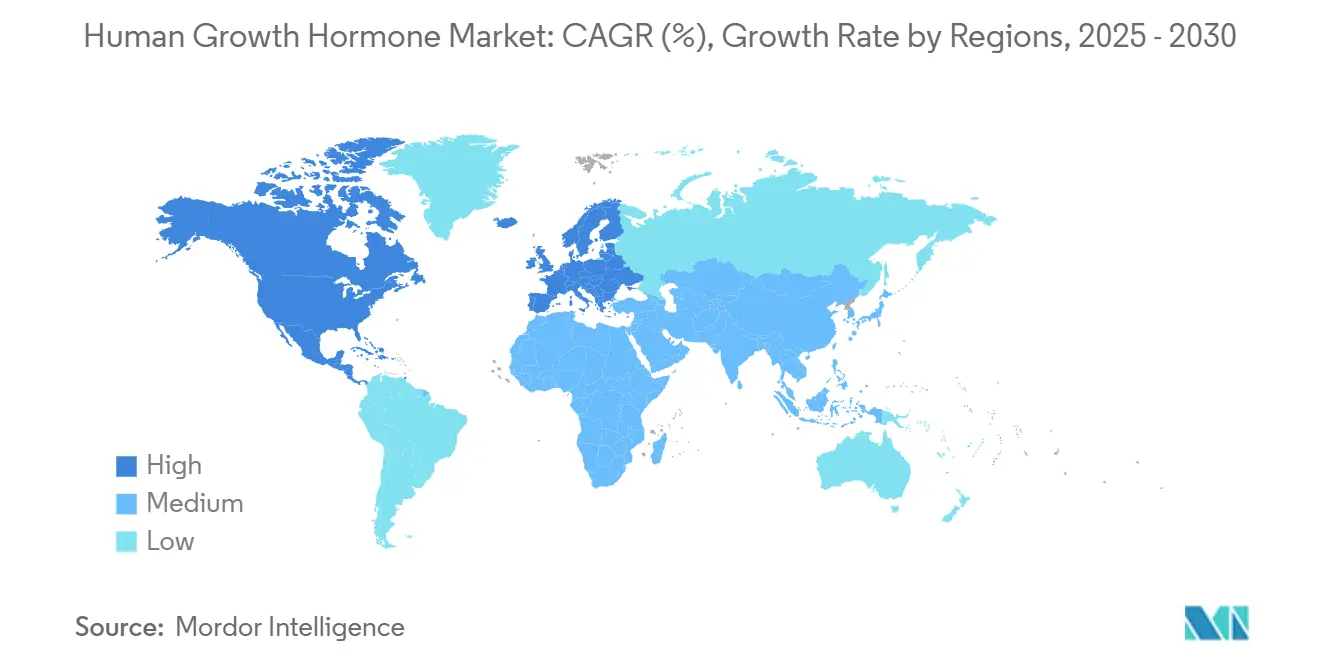
Competitive Landscape
The market is moderately concentrated, with originators retaining high share through portfolio breadth, scale manufacturing, and sophisticated patient-support systems. Novo Nordisk allotted USD 4.1 billion to enlarge United States capacity, while Eli Lilly committed USD 3 billion to injector-formulation lines, moves designed to mitigate shortages and underpin future volume growth. Ascendis Pharma leverages its TransCon platform to commercialize Skytrofa and negotiates platform collaborations, most recently with Novo Nordisk for metabolic programs.
Biosimilar players, headed by Sandoz, are escalating price rivalry; Sandoz posted 29% biosimilar revenue growth in first-half 2024 on Omnitrope strength and pipeline expansion to 28 molecules. Their growth pressures reference pricing, yet supply constraints mean discounts remain moderate in practice. Technology differentiation is now the core battleground as companies layer digital-health ecosystems—needle-free devices, adherence apps, connected pens—to capture clinician loyalty. Oral candidates from Lumos Pharma present a structural threat to injectable incumbents and could spark a fresh wave of competitive realignment should late-stage data prove compelling.
White-space opportunities persist in cardiovascular and cognitive-health indications where mechanistic evidence is accumulating. Companies that secure such labels could unlock add-on revenue while further entrenching share in the human growth hormone market.
Global Human Growth Hormone (HGH) Industry Leaders
AnkeBio Co. Ltd
Eli Lilly and Company
Ferring BV
Novo Nordisk AS
Ipsen S.A.
- *Disclaimer: Major Players sorted in no particular order
_Market_landscape.webp)
Recent Industry Developments
- March 2024: Aeterna Zentaris completed recruitment in its Phase 3 macimorelin trial for diagnosing childhood onset growth hormone deficiency.
- August 2023: FDA cleared once-weekly somatrogon-ghla (Ngenla) from Opko Health and Pfizer for pediatric growth hormone deficiency, confirming non-inferiority to daily somatropin.
- May 2023: The European Medicines Agency recommended once-weekly Sogroya for children aged 3 years and above, extending Novo Nordisk’s pediatric franchise.
Research Methodology Framework and Report Scope
Market Definitions and Key Coverage
Our study defines the human growth hormone (HGH) market as all prescription-grade recombinant somatropin products, daily and long-acting, sold through regulated channels for FDA or EMA approved clinical indications such as pediatric and adult growth hormone deficiency, Turner syndrome, idiopathic short stature, Prader-Willi syndrome, and small for gestational age cases. Ancillary delivery devices supplied with the drug are counted at factory transfer price.
Scope exclusion: Lifestyle-oriented "anti-aging" clinics, gray-market peptide vials, and illicit athletic use are excluded from Mordor's revenue pool.
Segmentation Overview
- By Application
- Growth Hormone Deficiency
- Turner Syndrome
- Idiopathic Short Stature
- Prader-Willi Syndrome
- Small for Gestational Age
- Chronic Renal Insufficiency
- By Route of Administration
- Subcutaneous
- Intravenous
- Intramuscular
- Oral / Buccal
- By Formulation
- Short-acting
- Long-acting
- By Distribution Channel
- Hospital Pharmacies
- Retail & Specialty Pharmacies
- Online Pharmacies
- By Patient Type
- Pediatric
- Adult
- By Geography
- North America
- United States
- Canada
- Mexico
- Europe
- Germany
- United Kingdom
- France
- Italy
- Spain
- Rest of Europe
- Asia-Pacific
- China
- Japan
- India
- Australia
- South Korea
- Rest of Asia-Pacific
- Middle East & Africa
- GCC
- South Africa
- Rest of Middle East & Africa
- South America
- Brazil
- Argentina
- Rest of South America
- North America
Detailed Research Methodology and Data Validation
Primary Research
Mordor analysts convened endocrinologists, hospital pharmacists, and reimbursement advisors across North America, Europe, and Asia-Pacific by phone and online surveys. These discussions validated real-world dosing volumes, biosimilar uptake speed, and average selling prices before we closed model assumptions.
Desk Research
We began with structured reviews of open datasets from bodies such as the U.S. FDA Orange Book, EMA Community Register, UNICEF procurement files, and customs trade codes that track recombinant proteins. Global disease burden estimates from the International Society for Pediatric and Adolescent Endocrinology and OECD health expenditure tables supplied prevalence and payer indicators. Financial filings, investor decks, and peer-reviewed journals on long-acting GH pipelines complemented the outlook. Proprietary lookups on D&B Hoovers and Dow Jones Factiva helped benchmark company revenue splits. This source list is illustrative; many other references supported verification and gap filling.
Market-Sizing & Forecasting
A top-down cohort model converts diagnosed patient numbers into treated patient volumes, adjusted by therapy adherence and weighted ASPs; selective bottom-up checks, such as sampled distributor sales and device unit shipments, keep totals grounded. Key market fingerprints include: (1) diagnosed GHD prevalence per 10,000 births, (2) annual switch rate to long-acting products, (3) biosimilar share trajectory, (4) average 12-month therapy cost, and (5) insurer reimbursement ceilings. Multivariate regression, bolstered by scenario analysis around biosimilar price erosion, projects values through 2030. Gaps in granular country data are bridged by proxy indicators like endocrine clinic density and insulin analog pricing correlations.
Data Validation & Update Cycle
Outputs pass variance scans versus Statista, WHO procurement values, and anonymized hospital charge data; discrepancies above three percent trigger re-checks. Reports refresh yearly, and analysts issue mid-cycle tweaks after major regulatory approvals or pricing shocks.
Credibility of Mordor's Human Growth Hormone Baseline
Published estimates differ because firms choose distinct market inclusions, currency bases, and refresh cadences. Our disciplined scope and transparent variable selection give decision makers a steadier gauge.
Key gap drivers are narrower inclusion of off-label adult wellness use by others, differing assumptions on biosimilar discount depth, and less frequent currency rebasing.
Benchmark comparison
| Market Size | Anonymized source | Primary gap driver |
|---|---|---|
| USD 7.97 Bn (2025) | Mordor Intelligence | - |
| USD 5.90 Bn (2024) | Global Consultancy A | Excludes long-acting launches, older ASP benchmarks |
| USD 7.65 Bn (2024) | Industry Analyst B | Uses uniform prevalence rates, no biosimilar price tiering |
The comparison shows how Mordor's annually refreshed model, tied to real treatment volumes and timely price shifts, offers a balanced, reproducible baseline that buyers can trust.
Key Questions Answered in the Report
What is the current Global Human Growth Hormone (HGH) Market size?
The human growth hormone market size reached USD 7.97 billion in 2025 and is forecast to expand to USD 14.27 billion by 2030.
Who are the key players in Global Human Growth Hormone (HGH) Market?
AnkeBio Co. Ltd, Eli Lilly and Company, Ferring BV, Novo Nordisk AS and Ipsen S.A. are the major companies operating in the Global Human Growth Hormone (HGH) Market.
How fast are long-acting growth hormone formulations growing?
Long-acting weekly or monthly products are registering a 13.65% CAGR from 2025 to 2030, the highest among all formulation types.
Which region has the biggest share in Global Human Growth Hormone (HGH) Market?
In 2025, the North America accounts for the largest market share in Global Human Growth Hormone (HGH) Market.
